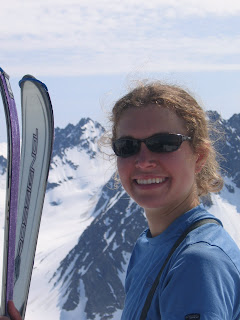 Again we would like to thank everyone who helped us make this trip a reality for us. It was the trip of a lifetime, not just a trip, but a way of life. Although we had to pull our boats out of the water for the last time on this expedition, many new ideas were born...
Again we would like to thank everyone who helped us make this trip a reality for us. It was the trip of a lifetime, not just a trip, but a way of life. Although we had to pull our boats out of the water for the last time on this expedition, many new ideas were born...Monday, July 30, 2007
Thank you!
 Again we would like to thank everyone who helped us make this trip a reality for us. It was the trip of a lifetime, not just a trip, but a way of life. Although we had to pull our boats out of the water for the last time on this expedition, many new ideas were born...
Again we would like to thank everyone who helped us make this trip a reality for us. It was the trip of a lifetime, not just a trip, but a way of life. Although we had to pull our boats out of the water for the last time on this expedition, many new ideas were born...Day 79
 The last day was our biggest at 53 miles. We paddled in brilliant sunshine with the wind at our back, through a gorgeous sunset, and into the dark where we used our ears and our compasses rather than our eyes to navigate. 21.5 hours after launch we landed in Bartlette Cove to catch the ferry back to Juneau.
The last day was our biggest at 53 miles. We paddled in brilliant sunshine with the wind at our back, through a gorgeous sunset, and into the dark where we used our ears and our compasses rather than our eyes to navigate. 21.5 hours after launch we landed in Bartlette Cove to catch the ferry back to Juneau.Saturday, July 28, 2007
A bit of icy history

In this place a person can watch one of the earths most fundamental geological processes in action as 12 tidewater glaciers calve into the sea. The bay was inhabited long ago by the Tlingits until the glacier surged forward forcing them across the Icy Strait to Hoonah. By the time Captain George Vancouver arrived in 1794, Glacier Bay was encased in ice, just a small indentation on the chart. The glaciers have receded 65 miles since Vancouvers time, although today some advance, others retreat, and a few hold their ground.
Friday, July 27, 2007
More than one way to move a boat
The Fortress of the Bears

Admiralty Island is home to the highest density of brown bears in North America. The island is known to the Tlingit as Kootznoowoo (Fortress of the Bear). These little fellers outnumber human residents nearly three to one. Almost everyday of the journey north of Vancouver Island we hauled our food high into the air to keep it safe from curious critters.
Whale Waters
 Crossing Frederick Sound, our desire to paddle with the whales was fulfilled as we were surrounded by flukes, fins, and blows. The Humpbacks accompanied us across to Admiralty Island as we continued our tour of the Alexander Archipelago. We weren't sure we were going to make the 15 miles across as we kept pausing to watch and photograph the whales, and listen to them breath.
Crossing Frederick Sound, our desire to paddle with the whales was fulfilled as we were surrounded by flukes, fins, and blows. The Humpbacks accompanied us across to Admiralty Island as we continued our tour of the Alexander Archipelago. We weren't sure we were going to make the 15 miles across as we kept pausing to watch and photograph the whales, and listen to them breath.North to Wrangell


North to Wrangell from Ketchikan we spent a weather day in the welcoming little community of Meyers Chuck. The wealth of generous people along the way continually renewed our faith in humanity. We paddled around the east side of Wrangell Island into grizzly country amid 6,000ft peaks and the murky waters of the Stikine River.
Paddling into the sunrise towards the Devil's Thumb east of Petersburg, AK
The mighty Stikine


Our diet was occasionally supplimented by friendly seafarers offering halibut, salmon, and king crab, yummie!! The Stikine River, its name derived from the Tlingit name Shtax' Héen, meaning "cloudy river" empties its glacier fed waters into the ocean near Wrangell after a 335 mile long journey through the rugged wilds of BC. Evidence of the river was apparent to us long before we reached Wrangell as the water grew murky with sediment. This particular morning our challenge of the day was trying not to drop all of our stuff in the mud, we didn't win.
Saturday, July 21, 2007
Southeast Exposure

 Our experience in Ketchikan was such a highlight thanks to our friends at Southeast Exposure. As you can see we were pretty excited about playing in the trees on your zip line and ropes course. Thank you so much for everything, we miss you guys & girls! Thanks for taking advantage of that 160 inches of fresh rain water/year to supply your operations.
Our experience in Ketchikan was such a highlight thanks to our friends at Southeast Exposure. As you can see we were pretty excited about playing in the trees on your zip line and ropes course. Thank you so much for everything, we miss you guys & girls! Thanks for taking advantage of that 160 inches of fresh rain water/year to supply your operations.Thursday, June 7, 2007
Friday, April 20, 2007
Wing boys and girls
Thursday, March 8, 2007
The Expedition: Paddle for Power
 Beginning from San Juan Island, Washington and finishing in Haines, Alaska we will kayak the “Inside Passage.” Not only will we kayak approximately 1300 miles, but we will also explore some of the coastal mountain ranges of British Columbia and southeastern Alaska by backcountry skiing along the way. We plan to use two distinct modes of travel. The kayak will allow us an intimacy with the cliffed, forested and beached coastline unmatched by any other oceangoing vessel. It allows for a closer relationship with the macro marine life of sea lions, seals and whales as well as the intertidal zones teeming with micro marine life. In honor of our shared passion for skiing we will carry skis on our kayaks as our second mode of travel. Similar to the intimacy of kayaking, this will allow us to explore the snow-covered peaks, which span the entire coast from Washington to Alaska.
Beginning from San Juan Island, Washington and finishing in Haines, Alaska we will kayak the “Inside Passage.” Not only will we kayak approximately 1300 miles, but we will also explore some of the coastal mountain ranges of British Columbia and southeastern Alaska by backcountry skiing along the way. We plan to use two distinct modes of travel. The kayak will allow us an intimacy with the cliffed, forested and beached coastline unmatched by any other oceangoing vessel. It allows for a closer relationship with the macro marine life of sea lions, seals and whales as well as the intertidal zones teeming with micro marine life. In honor of our shared passion for skiing we will carry skis on our kayaks as our second mode of travel. Similar to the intimacy of kayaking, this will allow us to explore the snow-covered peaks, which span the entire coast from Washington to Alaska.The power behind the paddle

As concerns about rising fossil fuel prices, climate change, and energy security increase, utilizing clean, local, and inexhaustible renewable energy resources can play a key role in addressing those concerns. We encourage you to help support renewable energy use and renewable resource development and awareness. Our upcoming expedition offers an outlet for you to support our sustainable, renewable energy powered future. One of our goals is to raise money and awareness for Renewable Energy Alaska Project (REAP.) REAP is as coalition of over forty organizations from across Alaska including urban and rural utilities, businesses, environmental groups, consumer groups, Alaska Native organizations, and State and Federal agencies, all working together to increase the development of renewable energy in Alaska. REAP believes that for economic and environmental reasons, Alaska, the United States, and the Earth will benefit greatly from the rapid development of renewable energy resources and that Alaska can and should be a leader in such development.
Expedition Members
Subscribe to:
Comments (Atom)








































